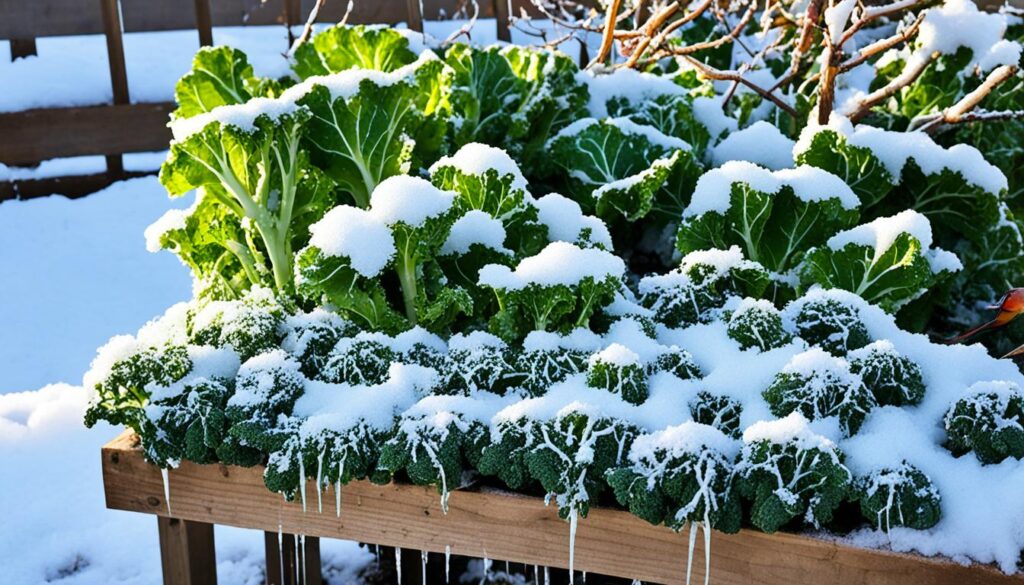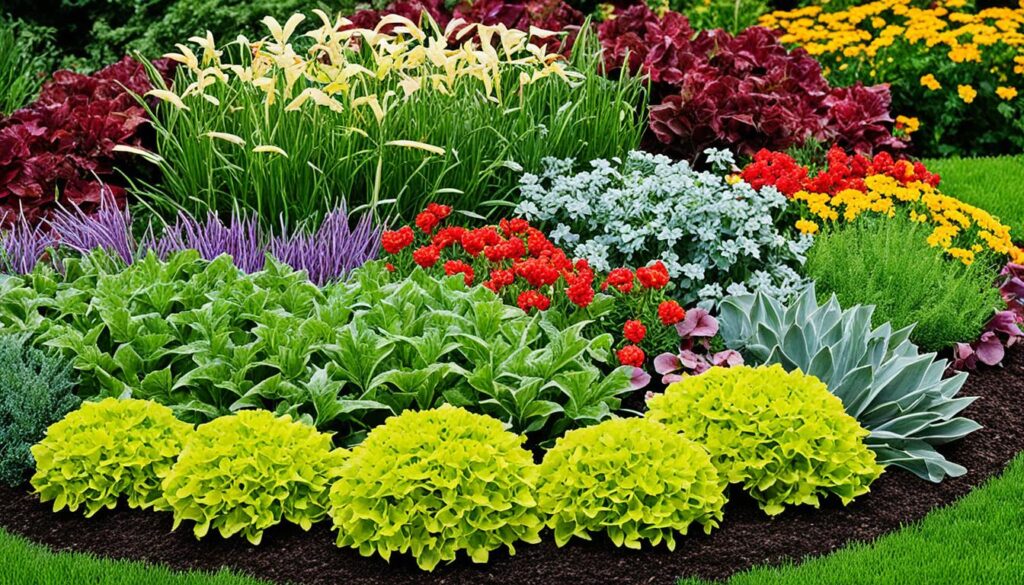Seasonal Guide to Companion Planting
Unlock the secrets to a thriving garden all year with our guide to companion planting. But what is companion planting, and how does it help your garden? Learn about strategic plant pairings to make your garden better.
Key Takeaways
- Companion planting is the practice of growing different plants together for mutual benefit.
- Discover the advantages of companion planting, from pest control to increased yields.
- Explore seasonal companion plant pairings for your garden, from spring to winter.
- Learn how to plan a companion planting garden for maximum effectiveness.
- Attract beneficial insects and deter pests with the right companion plants.
Understanding Companion Planting
Companion planting is a way to grow plants together to help each other. It’s an old method that says plants can help each other out. By doing this, each plant gets something good from the others in the companion planting basics.
What is Companion Planting?
It’s about making a garden where different plants live together well. By choosing the right plants to grow side by side, gardeners can make their gardens healthier and more productive. This means picking plants that attract good bugs, keep pests away, or make the soil better.
Benefits of Companion Planting
The benefits of companion planting are many and can change how you garden. Some main advantages are:
- Less pest damage from natural pest control
- Better soil nutrition and fertility
- More pollination and higher yields
- Smart use of garden space
- Beautiful and varied plantings
Learning about companion planting helps you make a garden that works well with nature.
“Companion planting is a time-honored gardening technique that allows plants to work together, resulting in a more productive and beautiful garden.”
Planning a Companion Planting Garden
When planning a garden, picking the right plants is key. Some plants help each other grow, while others can harm each other. It’s important to choose plants that work well together.
Choosing Compatible Plants
Look for plants that grow well together. Tomatoes and basil are great together because basil keeps pests away from tomatoes. Marigolds also help by fighting off pests in the soil.
Considering Plant Growth Habits
Think about how tall and big plants will get. Taller plants can shade smaller ones that need sunlight. Vines can climb up trellises, saving space in your garden.
| Plant | Companion Plants | Incompatible Plants |
|---|---|---|
| Tomatoes | Basil, Marigolds, Chives | Potatoes, Fennel, Dill |
| Carrots | Radishes, Chives, Rosemary | Dill, Parsnips |
| Lettuce | Carrots, Radishes, Cucumbers | Broccoli, Cauliflower |
Planning carefully will help you create a garden that works well together. This way, you get the most out of companion planting.
Spring Companion Planting
As the weather gets warmer and the earth awakens, it’s a great time to dive into spring companion planting. By thoughtfully pairing vegetables, herbs, and flowers, you can make a garden that flourishes all spring long.
Spring Vegetable Companions
When setting up your spring vegetable garden, think about which plants work well together. Asparagus and basil or marigolds can keep pests away and draw in good bugs. Broccoli and cabbage do well with nasturtiums, which lure aphids away. Carrots are happy with rosemary or sage, which keep carrot flies at bay.
Spring Flower Companions
Adding spring flowers to your garden can really boost the ecosystem. Flowers like borage, dill, and poached egg plants attract bees and butterflies, which are key for your garden’s success. These flowers also bring in beneficial bugs, like ladybugs and lacewings, that eat garden pests.
| Spring Vegetable | Companion Plants | Benefits |
|---|---|---|
| Asparagus | Basil, Marigolds | Pest deterrence, Beneficial insect attraction |
| Broccoli, Cabbage | Nasturtiums | Trap cropping, Pest deterrence |
| Carrots | Rosemary, Sage | Pest deterrence |
Choosing the right spring companion plants helps your garden grow well and look great. Enjoy the season’s abundance with a well-thought-out spring planting plan.
Summer Companion Planting
As summer comes, companion planting opens up new ways to make your garden better. It brings special pairings and strategies for the summer season. These can boost your garden’s productivity and beauty.
Summer is a great time to use plants that give shade and support to others. For example, tall corn plants can shade lettuce from the hot sun. Vines like cucumbers can grow up pole beans, helping each other out and saving space.
Summer is perfect for adding flowers that keep pests away and attract pollinators. Flowers like sunflowers, zinnias, and cosmos brighten up your garden. They also keep pests away and draw in helpful insects for your crops.
| Companion Plant | Benefit |
|---|---|
| Corn | Provides shade for lettuce and other leafy greens |
| Cucumbers | Climbs and intertwines with pole beans, providing mutual support |
| Sunflowers | Deter pests and attract pollinators |
| Zinnias | Deter pests and add vibrant color to the garden |
| Cosmos | Attract beneficial insects and pollinators |
By carefully choosing your summer plants and using companion planting, you can make a garden that’s full of life. It will be good for your plants and the environment too.
Fall Companion Planting
As summer ends and autumn arrives, the garden changes. It starts to focus on plants that do well in cooler weather and less sunlight. By choosing the right plants together, gardeners can make their gardens last longer, keep pests away, and make it look beautiful.
Fall Vegetable Companions
With the days getting shorter, vegetables like kale, brussels sprouts, and root crops shine. These plants do great in the cool. Adding garlic or sage near them keeps pests away. Radishes help by aerating the soil and drawing pests away from the main plants.
Fall Flower Companions
Flowers like chrysanthemums, asters, and marigolds are perfect for fall. They add color to the garden and attract helpful insects. These insects keep pests away. Adding these flowers to your garden keeps it healthy and full of life even in the cooler months.
| Fall Vegetable Companions | Fall Flower Companions |
|---|---|
|
|
Fall companion planting lets gardeners have a garden that’s full of life and looks great. It’s easy to take care of and keeps going even after summer ends.
Winter Companion Planting
When winter comes, companion planting is still key for your garden. By picking the right plants together, you can make a winter garden that thrives, even in tough conditions.
Winter Vegetable Companions
Winter companion planting helps protect delicate crops. Pair cold-hardy greens like spinach and kale with taller plants that block wind and frost. Onions and herbs like rosemary and thyme are great for winter, adding strength to your garden.
- Spinach: Pair with taller, bushy plants for wind and frost protection
- Onions: Provide a sturdy base for winter vegetable companions
- Rosemary and thyme: Hardy herbs that can withstand winter conditions
Arranging your winter plants wisely makes your garden stronger and more productive, even when it’s cold. Use companion planting to overcome winter gardening challenges and enjoy a rich harvest.

“Companion planting is a fantastic way to maximize the potential of your winter garden, even in the face of challenging conditions.”
Popular Companion Planting Combinations
Companion planting is a gardening method that pairs plants together for mutual benefits. Tomatoes and basil, and the “Three Sisters” of corn, beans, and squash, are top choices. These combinations help each plant grow better.
Tomato and Basil
Tomatoes and basil are a classic pair in gardening. Basil keeps pests away from tomatoes and makes them taste better. This duo is perfect for gardeners.
The Three Sisters: Corn, Beans, and Squash
The Three Sisters method has been used by Native American tribes for years. Corn, beans, and squash help each other out in many ways. Corn stalks support beans, and squash leaves keep weeds down and soil moist.
| Crop | Benefit |
|---|---|
| Corn | Provides structure for beans to climb |
| Beans | Fix nitrogen in the soil, improving corn and squash growth |
| Squash | Shades the soil, preventing weed growth and retaining moisture |
These combinations show how planting certain plants together can make a garden better. It’s all about creating a balanced garden ecosystem.
“Companion planting is a gardening technique that pairs certain plants together to create mutually beneficial relationships.”
Seasonal Companion Planting Guide
Crafting a thriving garden is all about understanding how plants work together. Seasonal companion planting lets you use these natural partnerships to boost growth, control pests, and increase productivity all year.
Whether you’re starting with spring veggies, summer flowers, or fall harvests, this guide will show you the best plant friends for each season. By choosing plants that grow well together, you can make a garden that fights pests and diseases. It will also draw in helpful insects.
Spring Companion Planting
In spring, pair leafy greens with radishes or carrots. These strong-smelling veggies keep pests away from your spring greens. Also, marigolds near tomato plants can fend off harmful insects and nematodes.
Summer Companion Planting
With the heat up, team peppers and eggplants with basil or borage. These friends not only taste better together but also bring in helpful pollinators to your garden.
Fall Companion Planting
When it gets cooler in fall, pair brassicas like kale and broccoli with aromatic herbs such as rosemary and thyme. These teams keep pests away and boost your fall crops’ health.

Using this seasonal companion planting guide, you can make a garden that thrives all year. Smart plant pairings boost growth, attract good bugs, and keep pests away.
Attracting Beneficial Insects
Companion planting is a great way to draw beneficial insects like pollinators and pest predators to your garden. By adding flowers full of nectar, you can attract bees, butterflies, and hoverflies. These insects will help pollinate your plants and eat pests.
Flowering Plants for Pollinators
Zinnias, cosmos, and sunflowers are great flowers that are full of nectar. They make your garden more diverse and healthy. These plants bring in many beneficial insects, including:
- Bees – essential for pollinating many fruits and vegetables
- Butterflies – add a touch of beauty while also pollinating flowers
- Hoverflies – feed on aphids and other garden pests
Adding flowering plants for pollinators to your garden makes it healthier and less dependent on chemicals. It also means you’ll need fewer pesticides. By attracting beneficial insects, your plants will do better and you’ll help the environment.
| Flowering Plant | Beneficial Insects Attracted | Garden Benefits |
|---|---|---|
| Zinnia | Bees, Butterflies, Hoverflies | Pollination, Pest Control |
| Cosmos | Bees, Butterflies, Ladybugs | Pollination, Pest Control |
| Sunflower | Bees, Butterflies, Lacewings | Pollination, Pest Control |
By using flowering plants for pollinators in your garden, you can attract beneficial insects. This makes your garden a healthy, balanced place.
Deterring Pests with Companion Plants
Companion planting is great for keeping pests away from your garden. By pairing plants that naturally keep pests away, you can make your garden healthier. Plants like garlic, mint, and marigolds keep insects away without harsh chemicals.
These plants also attract beneficial insects and help your plants grow strong. Adding them to your garden is a smart way to fight pests naturally. It makes your garden safe for you and the environment.
Using companion plants is good for all types of gardens. It’s a green way to keep pests away from your plants. With a little planning, your garden will be beautiful and pest-free, supporting a healthy environment.
FAQ
What is companion planting?
What are the benefits of companion planting?
How do I choose compatible plants for companion planting?
What are some good spring companion plants?
What about summer companion plants?
What are good fall companion plants?
What about winter companion planting?
What are some popular and effective companion planting combinations?
How can companion planting help attract beneficial insects?
How can companion planting help deter pests?
Source Links
- 10 Must-Have Blooms for Your 2025 Garden
- The Health Advantages of Gardening You Need to Know
- How to Create a Small Vegetable Garden Layout Plan: A Beginner’s Guide
- DIY Garden Projects for Small Spaces: Upcycling Ideas to Maximize Your Garden
- Watering Techniques for Small Gardens: Ensuring Your Plants Thrive
- Small Border Plants for Landscaping: Adding Beauty and Functionality to Your Garden
- Year-Round Small Space Gardening: Seasonal Planting Tips for Maximum Harvest
- Essential Tools for Small-Space Gardening: What You Really Need
- The Ultimate Guide to Container Vegetables: What to Grow in Small Spaces
- Budget-Friendly Gardening: How to Create a Thriving Garden on a Tight Budget
- How to Optimize Sunlight in Small Gardens: Tips for Better Plant Growth
- DIY Vertical Planters: Creative Ideas for Small Space Gardening
- Companion Planting for Small Vegetable Gardens: Boost Growth and Deter Pests
- Container Gardening Essentials: Choosing the Right Pots, Soil, and Plants
- Vertical Gardening Techniques: Maximizing Your Small Space with Climbers and Vines
- How to Build a Raised Bed Garden in a Small Backyard: Step-by-Step Guide
- The Best Vegetables for Small-Space Gardens: High-Yield Varieties You Need to Grow
- Smart Vegetable Garden Layouts for Small Spaces: Maximizing Your Green Thumb in Compact Areas
- 40. Best Practices for Managing a Sustainable Garden Year-Round
- Building a Wildlife Pond for Biodiversity
- Advanced Techniques in Sustainable Gardening
- How to Create a No-Till Garden
- The Mental Health Benefits of Gardening
- Using Technology to Enhance Sustainable Gardening
- Getting Certified Organic: Steps and Benefits

Leave a Reply